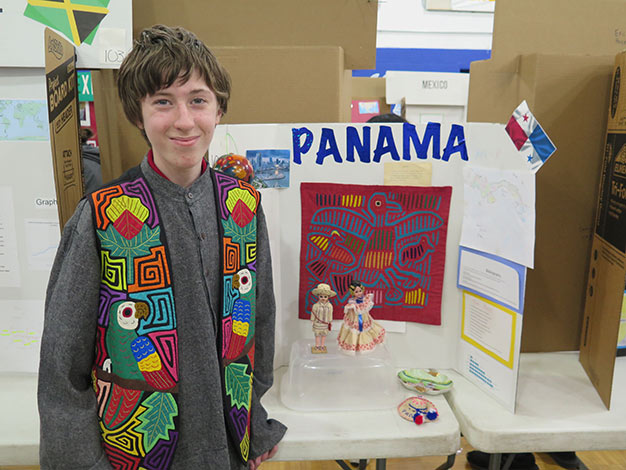
By Anne Marie Amacher
The Catholic Messenger
DAVENPORT — As a third-grader Keaton Prins gave a report on the Netherlands. “I thought it (had) an interesting culture,” said the now seventh-grader at All Saints Catholic School.
When the time came for students in grades six through eight to put on a culture fair, he knew he wanted to focus on the Netherlands. He and his fellow students held their culture fair March 5 in the school gym and cafeteria, before the COVID-19 coronavirus pandemic caused cancellation of classes.
Keaton’s report and poster included information he found fascinating: Amsterdam has 1,200 bridges and more than 1,000 windmills. His project also included a display of matryoshka (stacking) dolls.
Sandy Thomson, who teaches social studies to the students, said they started their project in January. They chose a country in which one of their ancestors had lived. Some of the students’ families have been in the United States for several generations and some have come much more recently.
As part of the project, students wrote an essay about their chosen country and covered three topics. A display board included a migration route to the United States and images of any variety of items that represented the country. They brought in food for the fair, played music, showed artifacts and clothing and did performances.
Thomson said some students love learning about their family’s culture and some “don’t like it as much.” A significant number of students did reports on Mexico or Vietnam. Nearly 30 total countries were represented at the fair.
Eighth-grader Estevan Prescott chose to report on Italy but could have done a project on Mexico because of his heritage. However, he decided to learn a little more about his Italian heritage from his mom’s side of the family. His great-grandparents came from Italy. “And I like Italian food.”
Sixth-grader Ella Heinrichs chose Germany as both sides of her family emigrated from there. She talked about the traditional clothing of lederhosen for men (leather shorts with suspenders) and dirndl for women (white blouse and apron with a colorful flared dress). Popular foods include pretzels and schnitzel (thin, breaded meat that is fried). Ella learned that in Germany around 28.6 percent of the people are Catholic, 26.6 percent Evangelical Christian, 4.9 percent Islamic and 35.9 percent atheist/agnostic.
Sixth-grader Dawyone Jones reported on Kenya. “I learned a lot. I would love to teach my family more about it (Kenya),” he said. His display featured traditional food, including sukama wiki, a type of greens eaten in Kenya.
Eighth-grader Addison Bailey selected Panama, where his great-grandfather was born. Although Addison is also German, Polish and Irish, he said he always wanted to learn more about Panama. He borrowed items of his grandmother’s, such as a mola jacket and quilt item, dolls and other items. A mola is a reversible applique panel of many colors made by women of the Cuna Indians who inhabit the remote San Blas Islands of Panama.
Bill Langley, grandparent of Asa and Netti Kantner at All Saints, enjoyed the culture fair. He noted that in Chicago people think of Iowa as mainly Germans and Belgians. “I can say there are a lot more cultures in Iowa. The students are so comfortable talking to grownups too.”











